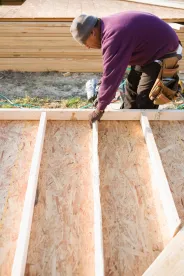Key Points
- The DRC will affect around 150,000 businesses in the construction industry
- It will require those receiving a supply of construction services to account for VAT directly to HMRC
- In particular, it will affect VAT registered businesses who make onward supplies of construction services
From 1 October 2020, a new reverse charge in relation to building and construction services (the 'Domestic Reverse Charge' or DRC) will radically affect the way in which businesses providing services that fall within the Construction Industry Scheme (CIS) will account for VAT. It is vital that affected businesses start to prepare now to ensure their business systems are ready for the new requirements.
How Does the DRC Work?
Under the DRC regime, the recipient (other than the end user) of construction services, or goods related to construction, (the customer) will itself have to account for VAT straight to HM Revenue and Customs (HMRC) instead of paying it to the supplier. The customer is able to recover the VAT, subject to the normal rules of recovery, as input tax.
Who Does It Apply To?
It applies to businesses (whether individuals, partnerships or companies) who are registered for VAT and who are contractors or sub-contractors under the CIS.
View Construction VAT Domestic Reverse Charge graphic.
Services Affected by the DRC
The DRC applies to business-to-business supplies in circumstances where both businesses are registered for VAT, there is an onward supply of construction services (i.e., the supply is not to an end user or intermediary1) and the parties are subject to the CIS. The DRC will, therefore, affect building and construction services supplied at standard or reduced rates, known as 'specified supplies'. Where services or goods made under a contract are subject to the DRC, all of the services provided under that contract will be subject to the DRC.
What Will This Mean for Your Business?
The DRC may have a significant impact on cash flow of businesses that rely on the VAT collected from customers to use as working capital until the VAT is paid over to HMRC. This will no longer be possible under the DRC and may result in financial difficulties for some businesses.
A review of existing contracts will be necessary to determine whether the DRC applies. This is likely to be an onerous and costly process for businesses, which HMRC acknowledges. In light of this, where a contractor can see that the DRC applies to more than 5 percent of its contracts, the contractor may apply the DRC to all of them.
In order to determine whether the DRC applies, it will be essential to determine whether customers are intermediaries/end users as the DRC does not apply to contracts with them. This may not always be apparent, so businesses should take steps to ask their customers and keep adequate records of the responses. If a customer is an intermediary's supplier or end user, VAT should be paid in the usual way.
Practical tips for business include:
- check whether the DRC affects sales, purchases or both;
- sub-contractors may need their customers to disclose whether they are the end of the supply chain or an intermediary supplier — this information can sometimes be commercially sensitive and could conflict with confidentiality clauses;
- ensure accounting software and systems are able to process the DRC;
- consider administrative changes — for example, when producing an invoice clearly state that VAT is due but the DRC applies and the customer is required to account for VAT directly to HMRC;
- confirm payment terms with customers;
- consider cash flow implications; and
- sub-contractors may need to change from quarterly returns to monthly returns.
Conclusion
HMRC has acknowledged that implementing the DRC may cause disruption and confirmed that they will take a light-touch approach in dealing with any errors made in the first six months of the legislation, where businesses have complied with the legislation and acted in good faith.
Guidance for businesses has been issued by HMRC, available here.
1 An intermediary is a VAT and CIS registered business that is 'connected' or 'linked' to an end user. To be connected or linked to an end user the intermediary supplier must either be in the same group of companies as the end user or the end user and intermediary must have relevant interests in the land where the construction works are being carried out.







 />i
/>i
